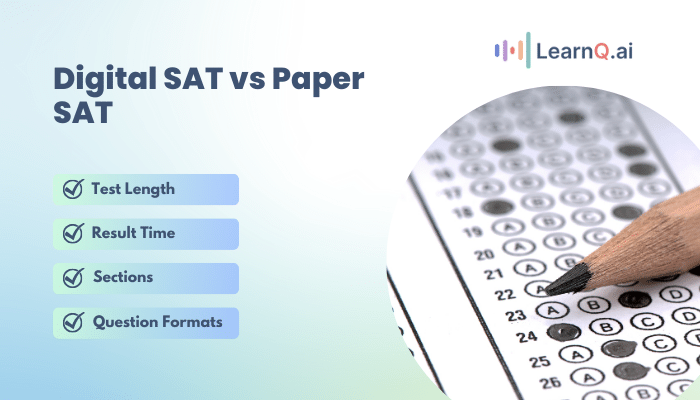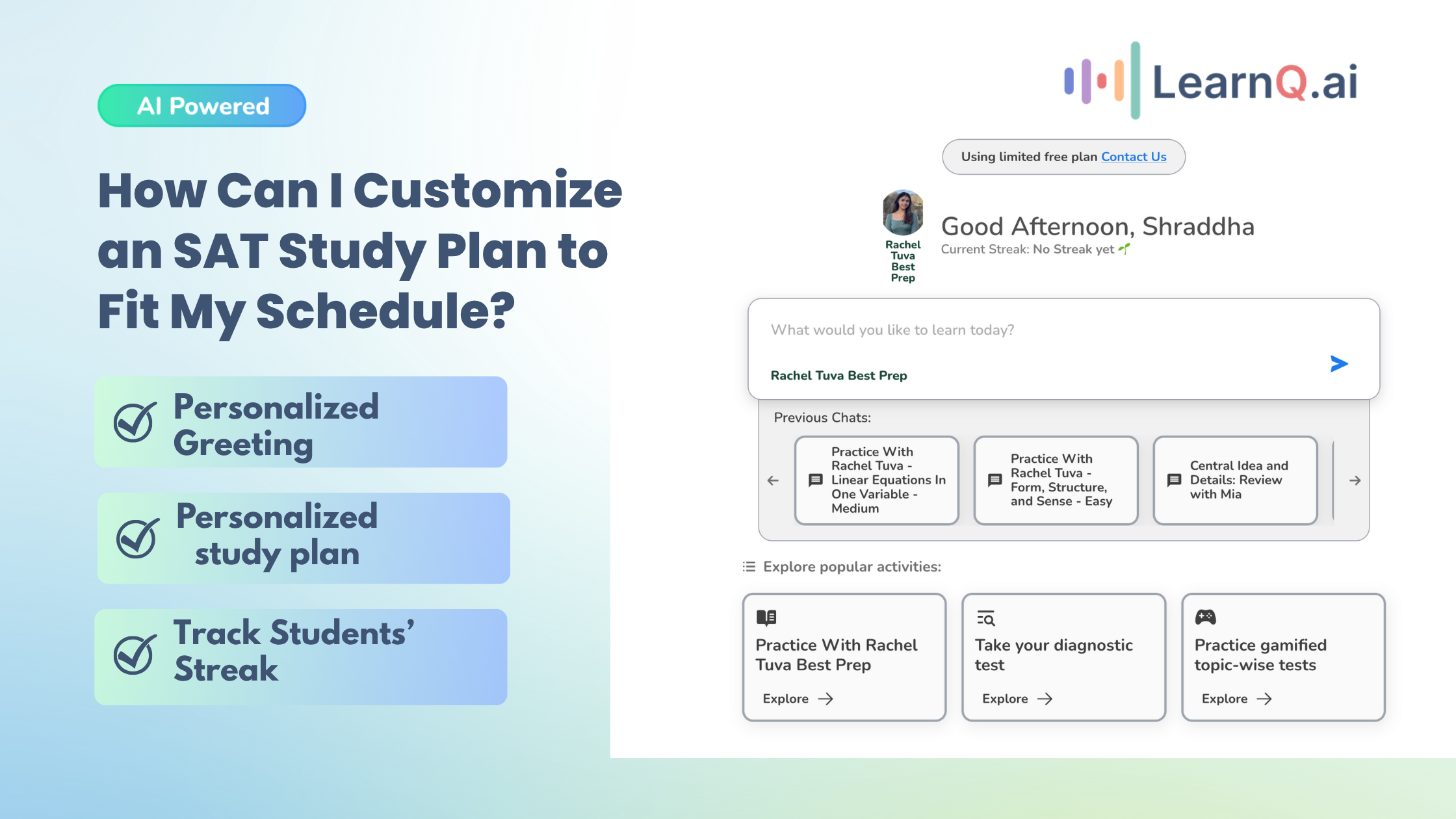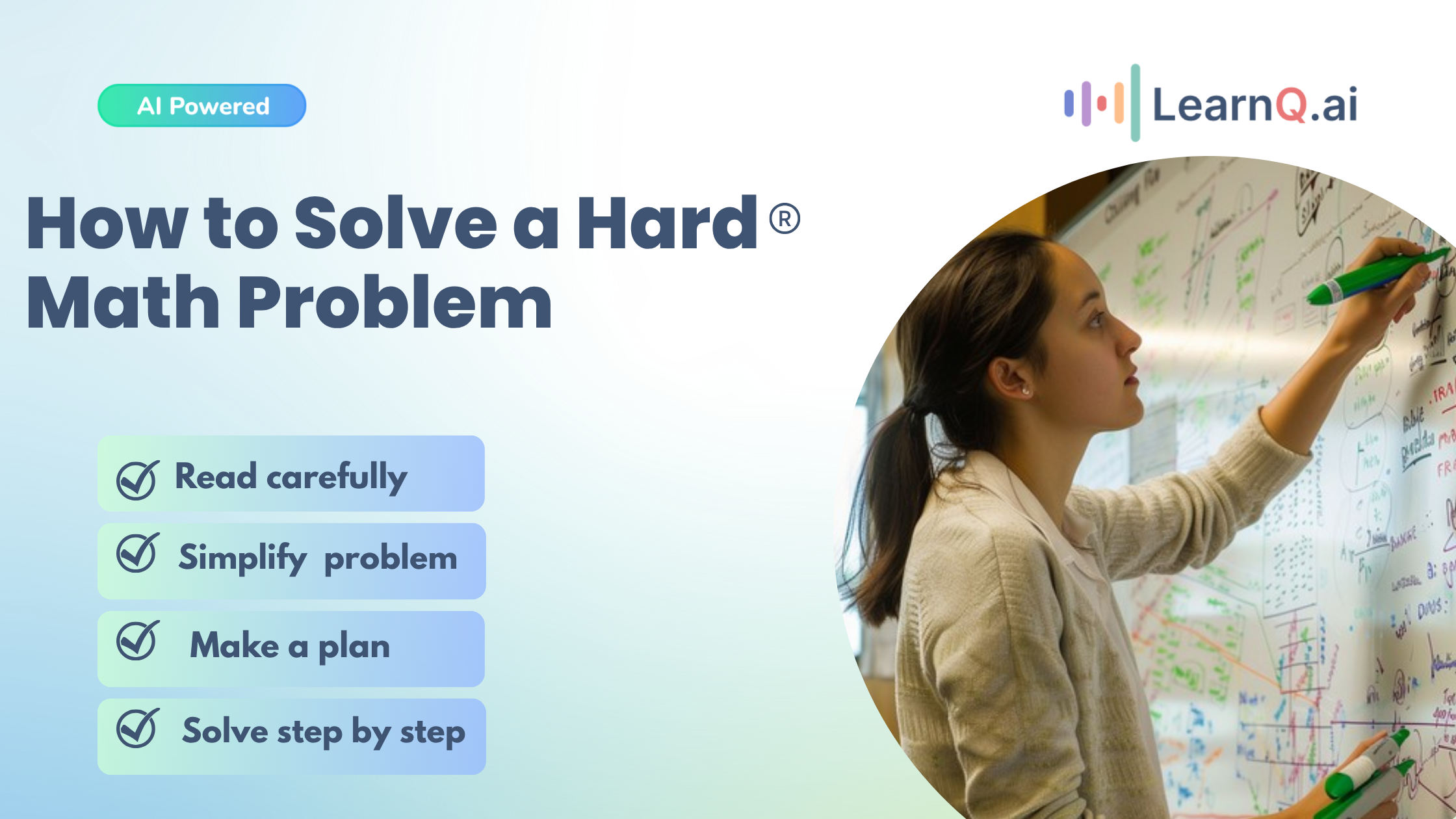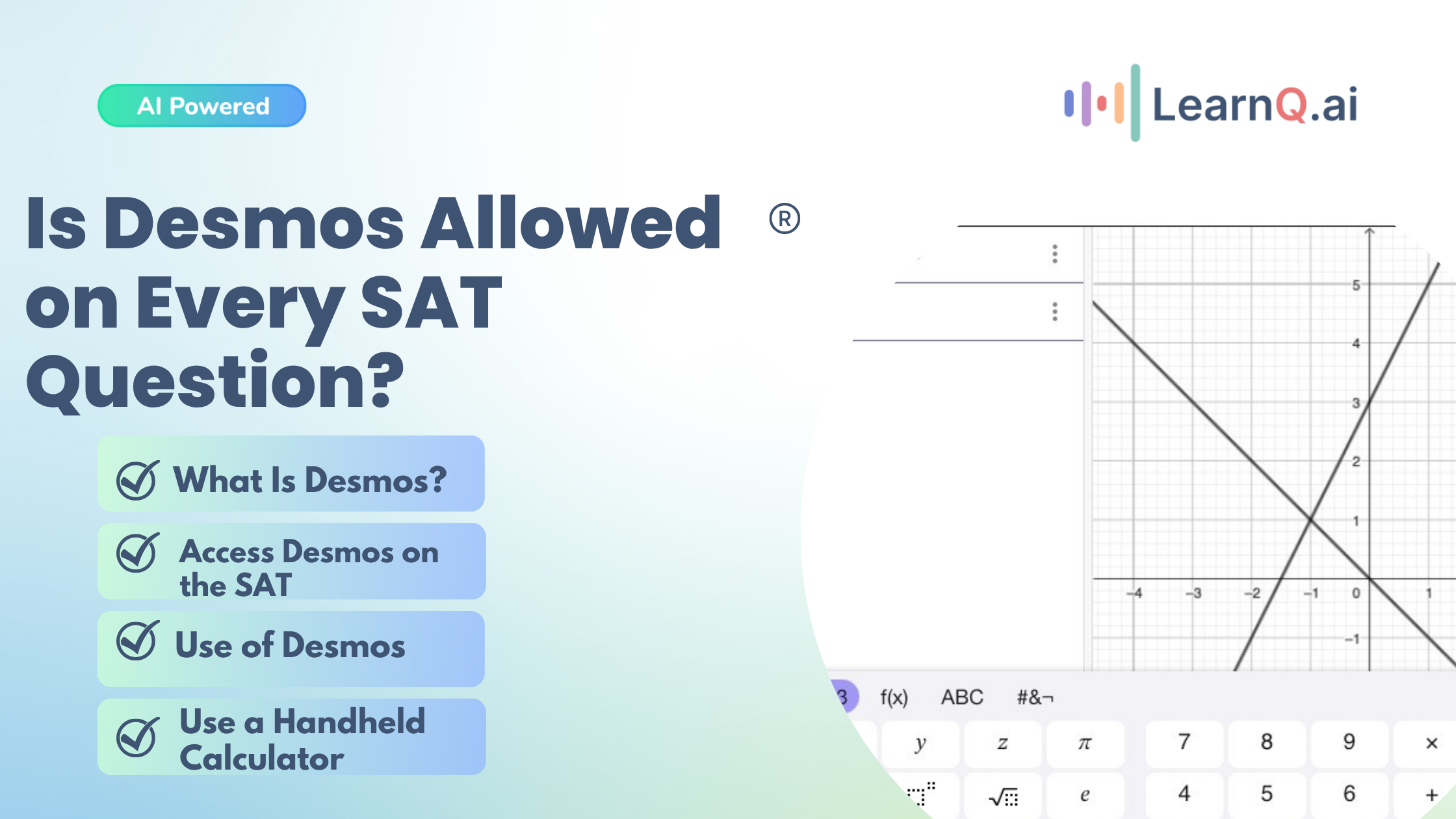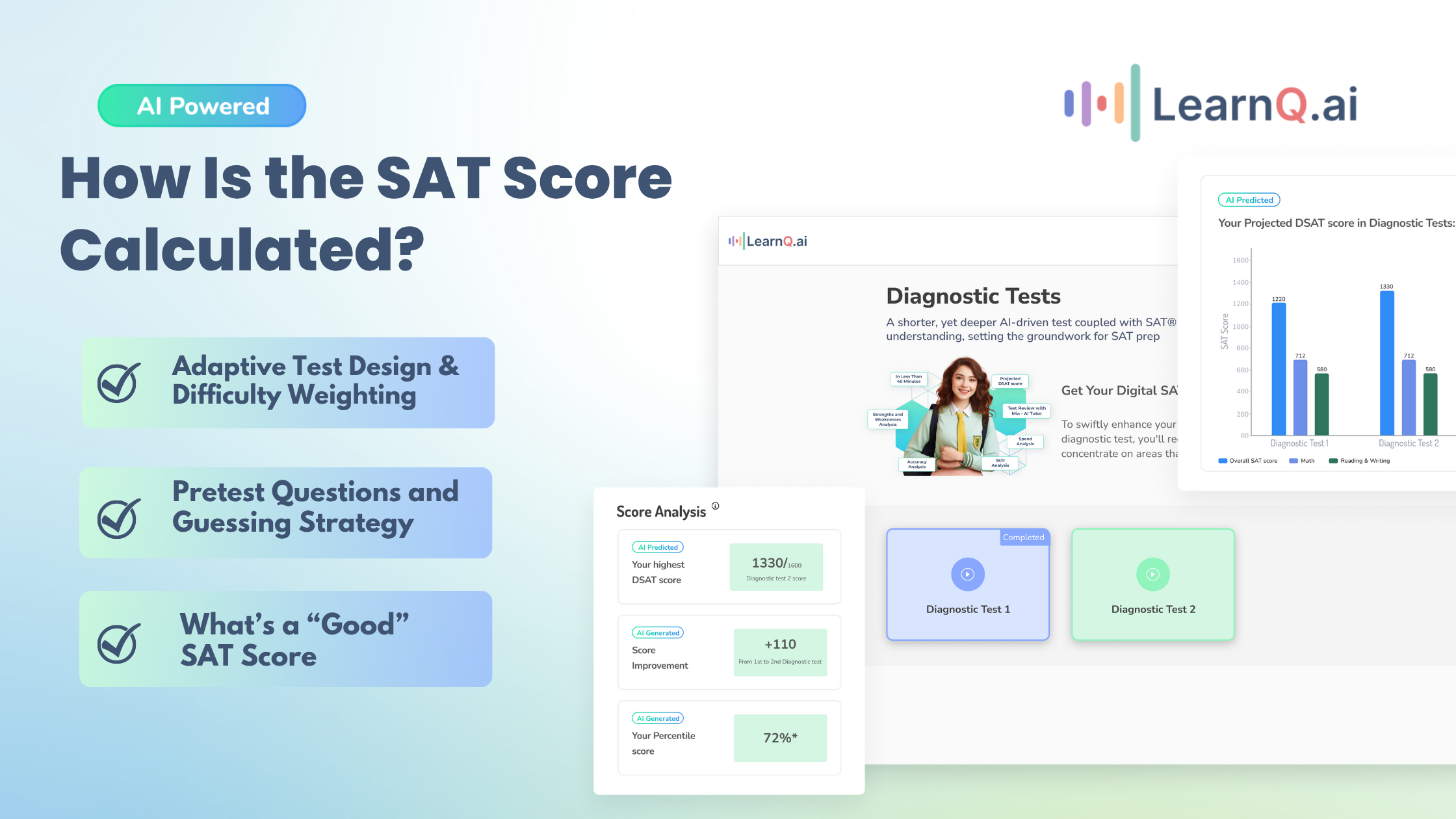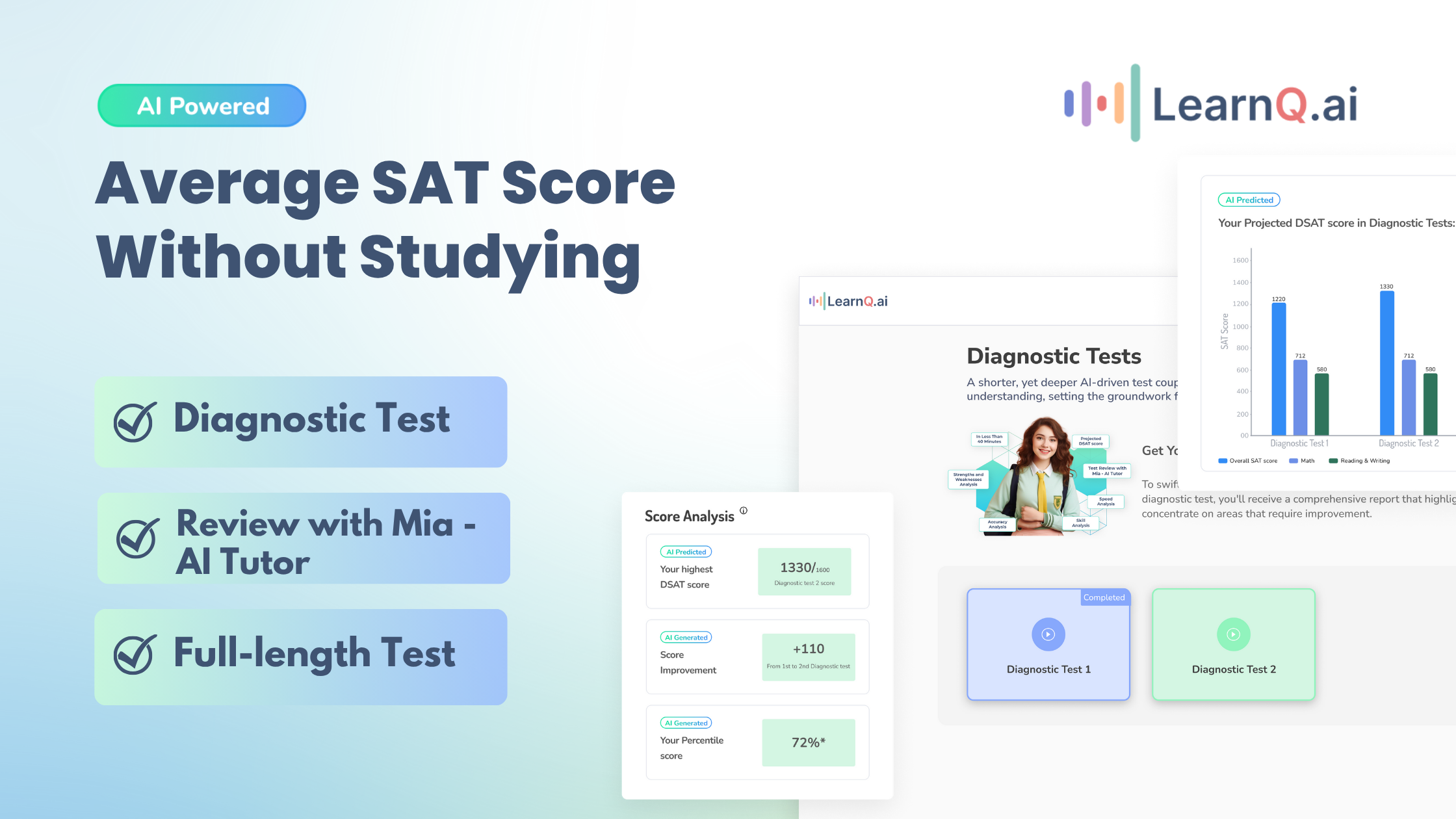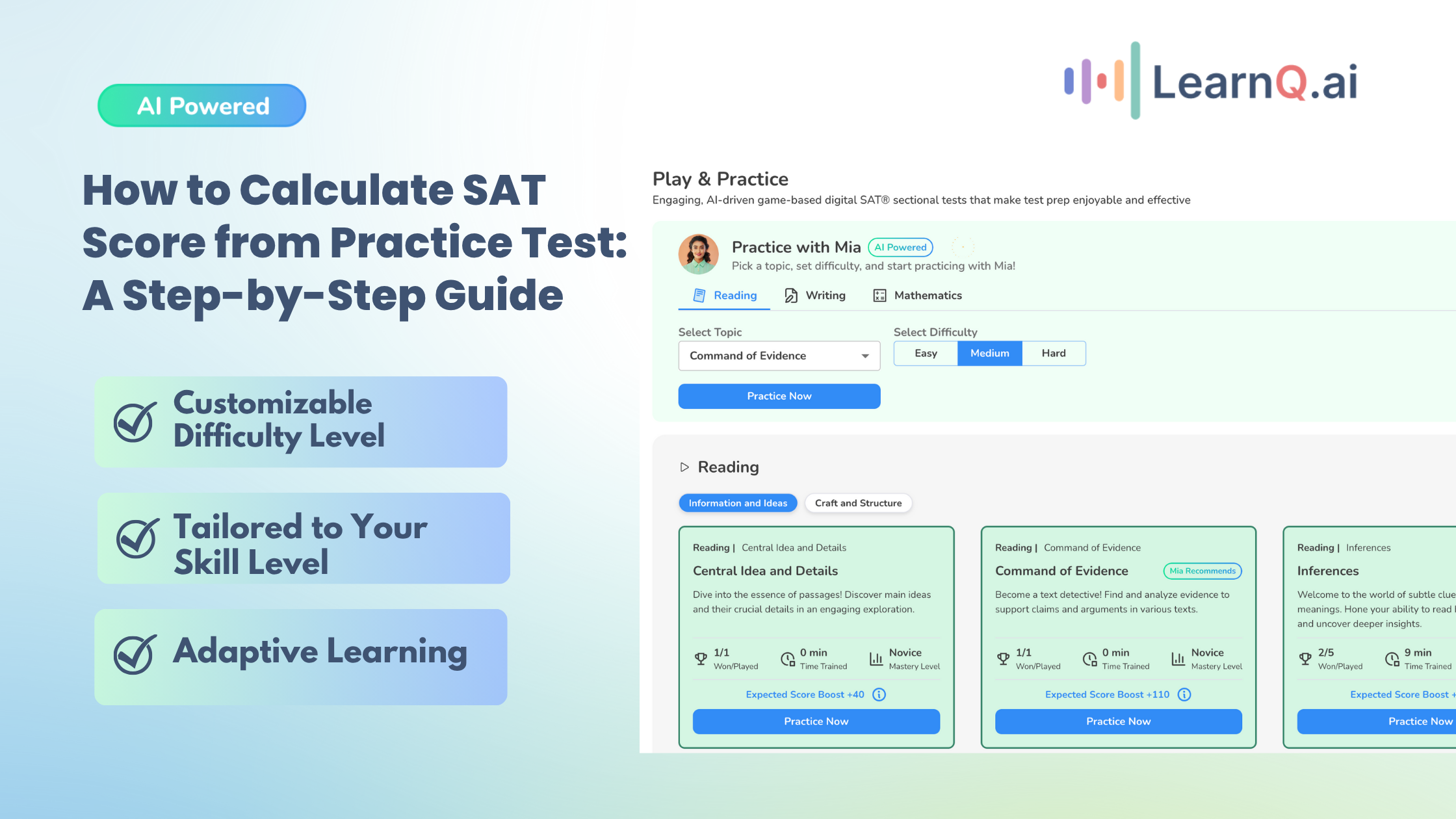Forget pencils and alarm clocks; the SAT’s gone digital, and it’s time to tap, swipe, and scroll your way to success! Since it’s a significant change, the shift is stirring up quite a bit of curiosity and, understandably, a fair share of questions.
One of those questions is, if this move to switch from paper-based to digital format is just about swapping physical test booklets for screens? And the answer is, absolutely not. The primary aim behind digitizing the SAT examination is to make the test more accessible and streamlined for students worldwide.
Let’s address the elephant in the room now – Digital SAT vs Paper SAT: What’s the extent of change you’re looking at?
We have compiled all the information in this Digital SAT vs Paper SAT table. Have a look!
| Digital SAT | Paper SAT | |
| Test length | Lasts for 2 hours and 14 minutesOffers a 10-minute break in between the ‘reading and writing’ and ‘math sections’ | Students typically sit for 3 hours to take this test without breaks. |
| Result time | Scores will be made available in a matter of few days: usually within 3-5 days after the test | Scores take a lot longer: typically 2-4 weeks after testing |
| Sections | Adaptive testing has made digital SAT a lot more personalized | Fixed sections for all students, regardless of performance. |
| Number of reading and writing questions | 54 (27/module) | Writing and language: 44 Reading: 52 |
| Number of math questions | 44 (22/module) | 58 |
| Question format | You can expect more varied questions, utilizing the digital format to its fullest | Traditional multiple-choice questions with some grid-ins |
| Features | Built-in accommodations like text-to-speech, adjustable font sizes, Desmos calculator, and screen color changes | Requests for accommodations must be made in advance, with limited options like large print and extended time for students with special needs |
| Preparation material | Digital practice tests and resources that mimic the test format closely have taken preparation to the next level, making studying fun rather than a task | Paper practice tests that are available cannot replicate the digital test experience |
Announcement of the SAT Going Digital in 2024: Analyzing its Impact on Students
A few crumbs of details on the Digital SAT vs Paper SAT format aren’t enough. It’s a big change, and students find themselves wondering what the actual impact of the SAT going digital will be. Will it benefit them or make things harder? Will it be too tough to adapt to the digital SAT format? If these are your questions, too, we have all the right answers that will silence the seeds of doubt in your mind. Tag along!
- Digital SAT is all about personalization and efficiency: The digital SAT format aims to modify the question difficulty level according to your real-time performance
- Expect enhanced accessibility and convenience: Digital tests come with built-in accessibility features and a Desmos calculator, making the digital SAT more inclusive
- Shift in study materials and methods: You can now utilize digital practice materials that simulate the test environment, including timing, interface, and types of questions
Still, worried that the digital SAT might be too hard to adapt to? We say, worry no more. The diagnostic and full-length practice tests on LearnQ.ai are designed to replicate an exact exam-like environment. You will also receive immediate feedback on every section of the test, which will further help you understand which weak areas require the most attention.
Availability
This section in our guide on Digital SAT vs Paper SAT addresses the most asked question – when will the Digital SAT examination be held in 2024? Here’s everything you need to know!
2024 Digital Test Dates for Students Outside the U.S. and in the U.S
The first date for the digital SAT examination in 2024 was March 9. If you missed this date, don’t fret. There are more dates available.
- May 4, 2024: Register by April 19, 2024
- June 1, 2024: The final spring date requires registration by May 16, 2024. Adjustments can be made until May 21, 2024
Anticipated August–December 2024 Test Dates
Looking ahead, the digital SAT might also be conducted on:
- August 24, 2024
- October 5, 2024
- November 2, 2024
- December 7, 2024
Digital Practice Tests Now Available
Many AI-powered platforms have emerged to bridge the gap between the Digital SAT and Paper SAT formats. Their aim? To help you adjust to the new format before you take the actual examination. Out of the many digital SAT practice test providers, LearnQ.ai is offering class-apart services.
- The SAT practice questions on LearnQ.ai closely mimic the practice questions you can find in the Bluebook
- You will get an advanced AI tutor, Mia, to help you understand the topics in great details
- The full-length and sectional practice tests on the platform are gamified. This means that unlike the traditional experience that you’ll get on the College Board Website, practicing on LearnQ.ai will be a lot more engaging and fun
- By taking these tests, you’ll familiarize yourself with the digital format, including how questions are presented and how to navigate through the test efficiently
- You’ll be able to practice under timed conditions to get comfortable with the pace of the digital test
Remember, practicing with the right materials and platforms will help you understand Digital SAT vs Paper SAT in great detail. And familiarizing yourself with the differences, similarities, and tools will prepare you to tackle and champion the digital SAT exam confidently.
Also Read: Top 5 AI Powered Digital SAT Providers
LearnQ.ai is Powered by VEGA AI—Is your Institute Next?
Give students a Duolingo-style test-prep platform with Shopify-level customization for tutors and institutes.
Consistencies With The Paper SAT
Despite the significant shift to digital, the core of the SAT remains consistent with its paper predecessor in several key aspects. This brings us to the next section in our guide on Digital SAT vs Paper SAT. Here, we will discuss the similarities between the two formats. Let’s get started!
Test Content and Skills Assessment
Going digital does not mean you are stepping into an entirely alien domain. That’s because:
- Like the paper SAT, the digital SAT continues to assess the same skills and knowledge areas: reading, writing, and Math
- The types of questions, although delivered digitally, aim to measure your readiness for college in the same way
SAT Scores Will Use the Same Scale
Both formats of the test use the traditional scoring scale, ranging from 400 to 1600 points. This consistency will ensure that scores are comparable across different formats, maintaining equity and fairness.
Testing Locations Remain the Same
Much like the paper SAT, the digital SAT cannot be taken at home. It will be conducted in schools and other designated testing centers, as testing in a controlled environment is crucial to rule out cheating during the exam.
Accommodations for Students with Needs
- More time can be provided to complete the sections for those who qualify
- Large print, magnification, and the use of assistive technology can be permitted
- Provision of a scribe or a reader can also be made
- For specific medical needs, students can apply for unique accommodations such as wheelchair accessibility and checkups to monitor blood sugar levels
Changes With The Digital SAT
We’ve tackled the similarities in great detail, which brings us to the most important topic in our guide on Digital SAT vs Paper SAT: the key changes in sections and modules!
Let’s get things moving!
The digital SAT maintains its core focus areas but modifies how content is presented to better align with digital delivery. For example:
- Evidence-based reading and writing integrates more interactive questions, leveraging hyperlinks for directing to specific parts of passages
- Math includes interactive problems that may involve manipulating graphical elements on-screen
Let’s now dissect each section in detail.
The Reading and Writing Section
The Reading and Writing section of the Digital SAT introduces a two-stage adaptive format. This format aims to more precisely assess students’ abilities by adjusting the difficulty of questions based on performance.
Here’s a closer look:
- Structure: The section is divided into two modules. Each module contains 25 operational questions and 2 pretest questions. You have 32 minutes to complete each module, totaling 64 minutes for the entire section
- Content Focus: Questions cover various topics, including literature, history/social studies, humanities, and science. The test evaluates skills through discrete, four-option multiple-choice questions and incorporates informational graphics such as tables, bar graphs, and line graphs to assess your ability to interpret data
The Math Section
The Math section also adopts the two-stage adaptive format, which tailors the difficulty level of questions to each student’s performance in real time. Here’s what this looks like:
- Structure: Similar to the Reading and Writing section, the Math section is split into two modules. Each module features 20 operational questions and 2 pretest questions, with 35 minutes allotted for each, summing up to 70 minutes for the entire section
- Question types: The majority of the questions are discrete, four-option multiple-choice (about 75%), with the remainder being student-produced response (SPR) types (about 25%). The content focuses on a variety of topics, including science, social science, and practical, real-world scenarios
In-test Features
The digital SAT introduces several features, listed below, to aid in test-taking:
- Digital timer: Helps you keep track of remaining time with customizable alerts
- Mark for review: Allows you to flag questions you wish to revisit within a section
- On-screen calculator: A standard scientific calculator (identical in functionality to models like the TI-84) is accessible for math questions, facilitating quicker calculations and reducing the need for manual computation
New Question Types
The digital SAT introduces novel question types to utilize digital testing’s capabilities. Examples include:
- Drag-and-drop answers for categorizing or sequencing items based on reading passages or solving math problems
- Selectable hotspots, where students choose parts of a graph or text as their answer
Adaptive Testing in Digital SAT
Now that you are entirely aware of the breakdown of digital SAT based on sections and modules, let’s pivot to the next big thing in our guide on Digital SAT vs Paper SAT: the adaptive testing nature of digital SAT!
With the introduction of adaptive testing, the digital SAT ensures that while the test content’s difficulty level and type are consistent, the specific questions each student encounters will differ.
This approach personalizes the testing experience and enhances security, making it virtually impossible for test-takers to share test content.
Here are the key benefits of adaptive testing that help students:
- Personalization: The adaptive format provides a testing experience that is more closely aligned with each student’s individual abilities
- Score accuracy: By adjusting the difficulty of questions based on performance, the digital SAT can more accurately assess a student’s mastery of the material, leading to scores that better reflect their true abilities
To get hands-on experience with these new section formats and question types, experimenting with LearnQ.ai’s adaptive practice tests can give you a real competitive edge.
Digital SAT Software and Tools
One of the reasons why the switch from paper SAT to digital SAT opened a can of so many anxious questions is that dSAT uses many in-built tools.
Although the purpose of these tools and software is to make the examination less intimidating for students, there’s still a need to get familiar with these tools in order to benefit from them.
Hence, this section in our guide on digital SAT vs Paper SAT is dedicated to the different tools you can now benefit from while taking the exam! Have a look.
Built-in Desmos Graphing Calculator
The digital SAT includes a built-in Desmos graphing calculator for the Math section. This advanced calculator is known for its user-friendly interface and powerful features, allowing students to perform various calculations.
The calculator is available directly within the test interface, ensuring students don’t need to bring a physical calculator.
Here are the key benefits of the Desmos graphing calculator:
- Every student has access to the same high-quality calculator, ensuring fairness and removing the variability of students having different types of physical calculators
- Desmos offers a wide range of functions that can be particularly beneficial for visualizing complex math problems, including graphing multiple equations to find intersections, exploring transformations, and analyzing data
- The on-screen calculator can speed up calculations, allowing students to spend more time on problem-solving rather than manual computations
Enhance your Digital SAT study routine with AI-driven insights and personalized practice tests.
In-test Tools Similar to Paper Test Interface
This guide on Digital SAT vs Paper SAT format also tackles the ghost of similar tools and features between the two testing formats!
- The digital interface of the SAT is designed to feel familiar with paper tests
- Navigation buttons, question layouts, and the overall look and feel are made to be intuitive for those transitioning to the digital format. This includes easy-to-use options for moving between questions, reviewing instructions, and managing test time effectively
Flagging Questions, Highlighting Text, and Elimination of Answer Choices
- Students can flag questions for review, a critical feature allowing test-takers to quickly return to questions they are unsure about, ensuring they have the opportunity to review their answers before submitting their test
- Text highlighting and answer choice elimination are also available, enabling students to interact with the test materials in ways that can enhance comprehension and strategy
Preparation Strategies for the Digital SAT
The next inclusion in our guide on Digital SAT vs Paper SAT is crucial: preparation strategies that will see you through that dream college of yours!
Here’s a comprehensive section that will prepare you to not only take the examination but also clear it with top scores.
Use a Practice Platform that Mimics Real Test Conditions
Practicing under conditions that closely replicate the actual test environment is essential. This means using a computer or tablet, timing yourself strictly according to the dSAT’s timing, and familiarizing yourself with the digital interface you’ll use on test day.
Want to make sure that you have mastered all the new tools integrated in the digital SAT exam before taking it? Keen to practice with questions as good as the Bluebook questions? If so, LearnQ.ai is the platform you are looking for! Try the platform for free and get started on your journey to success!
Familiarize Yourself With the Digital Testing Application
Practice on digital platforms that can help you understand:
- How to use in-test tools
- The process for flagging questions for review
- The method to navigate between questions
Review Sample Questions and Practice Tests
Engage with as many sample questions and full-length digital practice tests as possible. This exposure will enhance your test readiness by familiarizing you with the types of questions asked and improve your adaptability to the digital format’s unique question styles, such as drag-and-drop or select-in-passage questions.
Benefits of Working With a Trusted Professional for Review
Consider working with Mia, the AI tutor on LearnQ.ai. With her high intellectual skills, she can be trusted to help you develop a deeper understanding of all the topics.
You can also use the digital tools on the platform that use SWOT analysis to identify your strengths and weaknesses. It will give you a chance to come up with a targeted study plan.
Although transitioning to a digital format may seem daunting, it offers an opportunity for a more personalized and efficient testing experience.
- Approach your preparation with an open and agile mindset
- Embrace the changes as they come, and view each practice session as a step toward mastering the digital SAT
Remember, flexibility and adaptability are vital in turning challenges into opportunities for growth.
Also Read: Helpful Last Minute SAT Tips for Test Day

Digital SAT vs Paper SAT : Summary Of All Difference
With so many things explained at length in our guide on Digital SAT vs Paper SAT, we don’t want you to forget the main ones! So, this highlight section will serve as a reminder of everything you need to remember about the digital SAT before you take the examination.
Structural Changes and Retained Similarities
- Adaptive testing: The dSAT employs a section-level adaptive testing model, where the difficulty of the second part of each section adapts based on your performance in the first part
- Test length and time: The dSAT is shorter (just a 2 hour and 14 minute test), aiming to reduce test fatigue
- Scoring scale: The dSAT maintains the SAT’s traditional 400-1600 scoring scale
- Core skills assessment: Despite the digital transition, the dSAT continues to assess the same core competencies in reading, writing, and math
- Content areas: The emphasis on evidence-based reading, writing, and math problem-solving remains central to the assessment’s goals
Digital SAT vs Paper SAT: A Snapshot of all the Key Differences
| Paper SAT | Digital SAT (dSAT) | |
| Format | Paper-based, linear testing | Computer-based, adaptive testing |
| Test length | 3 hours | 2 hours and 14 minutes |
| Question types | Traditional multiple-choice and grid-ins | Includes interactive question types |
| Total number of questions | 154 | Approximately 98 |
| Adaptive testing | Not provided | Adaptive testing is the heart and soul of digital SAT |
| Scoring results | Takes 2-4 weeks | Takes 3-5 days |
| Essay section | Included | Excluded |
| Preparation materials | Paper practice tests | Digital practice tests mimicking actual test format |
| Math section tools | Physical calculator allowed on certain parts | Built-in digital graphing calculator for the math section |
FAQs
1. Is the Digital SAT available to take online from any location?
While the test is administered digitally, it is unavailable for remote or home testing. It must be taken at official testing centers, which include schools and other designated locations.
2. How does the adaptive nature of the Digital SAT affect its difficulty compared to the Paper SAT?
The adaptive testing nature of the digital SAT exam is designed to match the difficulty of questions to the test-takers ability level. While individual questions may feel more tailored, the overall difficulty is calibrated to be consistent with the paper SAT, ensuring that scores are comparable across formats.
3. When can I take the Digital SAT examination in 2024?
In 2024, the Digital SAT (dSAT) examination dates and their respective registration deadlines are as follows:
March–June 2024 Test Dates
March 9, 2024
- Registration deadline: February 23, 2024
- Deadline for Changes, Regular Cancellation, and Late Registration: February 27, 2024
May 4, 2024
- Registration deadline: April 19, 2024
- Deadline for Changes, Regular Cancellation, and Late Registration: April 23, 2024
June 1, 2024
- Registration deadline: May 16, 2024
- Deadline for Changes, Regular Cancellation, and Late Registration: May 21, 2024
Anticipated August–December 2024 Test Dates
- August 24, 2024
- October 5, 2024
- November 2, 2024
- December 7, 2024
LearnQ.ai is powered by VEGA AI—Is your institute next?
Offer students a Duolingo-style test-prep platform with Shopify-level customization for tutors and institutes.






Conclusion
Mastering any examination is done through hard work and preparation from the right sources. This happens to be a lot more applicable for the SAT exam because not only is SAT one of the most challenging exams in the world, but it has also camouflaged to a new format: the digital SAT. We have already explained everything you should know about Digital SAT vs Paper SAT!
The only thing you should now focus on is mastering the digital format through LearnQ.ai’s play and practice feature. The platform has analytics tools to offer real-time, detailed feedback, and you get to practice with questions that mimic those from Bluebook.
So why the wait now? Take a diagnostic test with LearnQ.ai today and determine where your preparation currently stands and how to improve your scores!

